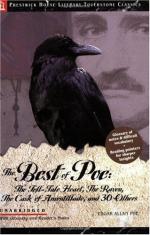Poe’s raven is a distinct conception; the incarnation of a mourner’s agony and hopelessness; a sable embodied Memory, the abiding chronicler of doom, a type of the Irreparable. Escaped across the Styx, from “the Night’s Plutonian shore,” he seems the imaged soul of the questioner himself,—of him who can not, will not, quaff the kind nepenthe, because the memory of Lenore is all that is left him, and with the surcease of his sorrow even that would be put aside.
The Raven also may be taken as a representative poem of its author, for its exemplification of all his notions of what a poem should be. These are found in his essays on “The Poetic Principle,” “The Rationale of Verse,” and “The Philosophy of Composition.” Poe declared that “in Music, perhaps, the soul most nearly attains the great end for which, when inspired by the Poetic Sentiment, it struggles—the creation of supernal Beauty.... Verse cannot be better designated than as an inferior or less capable music”; but again, verse which is really the “Poetry of Words” is “The Rhythmical Creation of Beauty,”—this and nothing more. The tone of the highest Beauty is one of Sadness. The most melancholy of topics is Death. This must be allied to Beauty. “The death, then, of a beautiful woman is, unquestionably, the most poetical topic in the world,—and equally is it beyond doubt that the lips best suited for such a topic are those of a bereaved lover.” These last expressions are quoted from Poe’s whimsical analysis of this very poem, but they indicate precisely the general range of his verse. The climax of “The Bells” is the muffled monotone of ghouls, who glory in weighing down the human heart. “Lenore,” The Raven, “The Sleeper,” “To One in Paradise,” and “Ulalume” form a tenebrose symphony,—and “Annabel Lee,” written last of all, shows that one theme possessed him to the end. Again, these are all nothing if not musical, and some are touched with that quality of the Fantastic which awakes the sense of awe, and adds a new fear to agony itself. Through all is dimly outlined, beneath a shadowy pall, the poet’s ideal love,—so often half-portrayed elsewhere,—the entombed wife of Usher, the Lady Ligeia, in truth the counterpart of his own nature. I suppose that an artist’s love for one “in the form” never can wholly rival his devotion to some ideal. The woman near him must exercise her spells, be all by turns and nothing long, charm him with infinite variety, or be content to forego a share of his allegiance. He must be lured by the Unattainable, and this is ever just beyond him in his passion for creative art.




